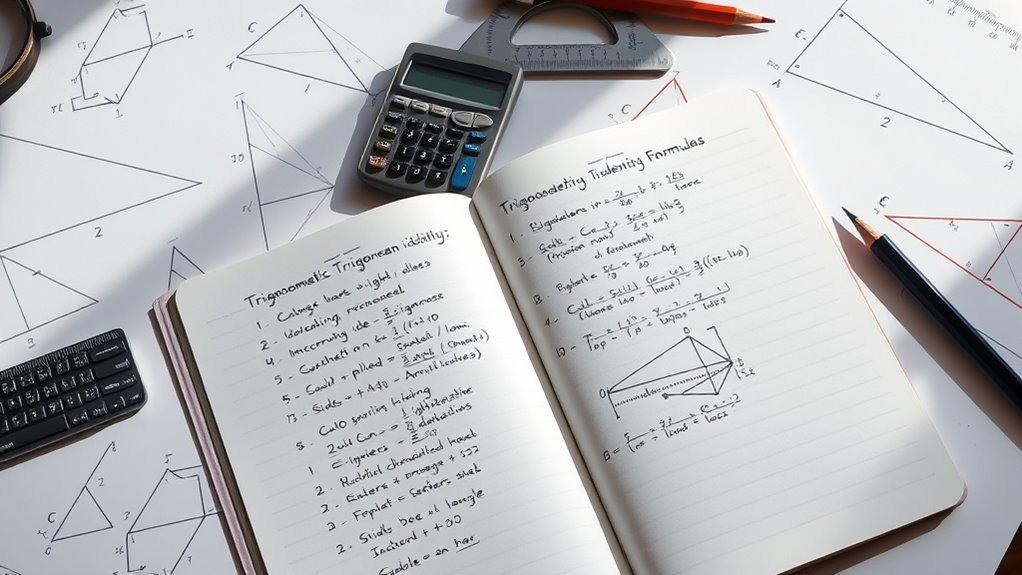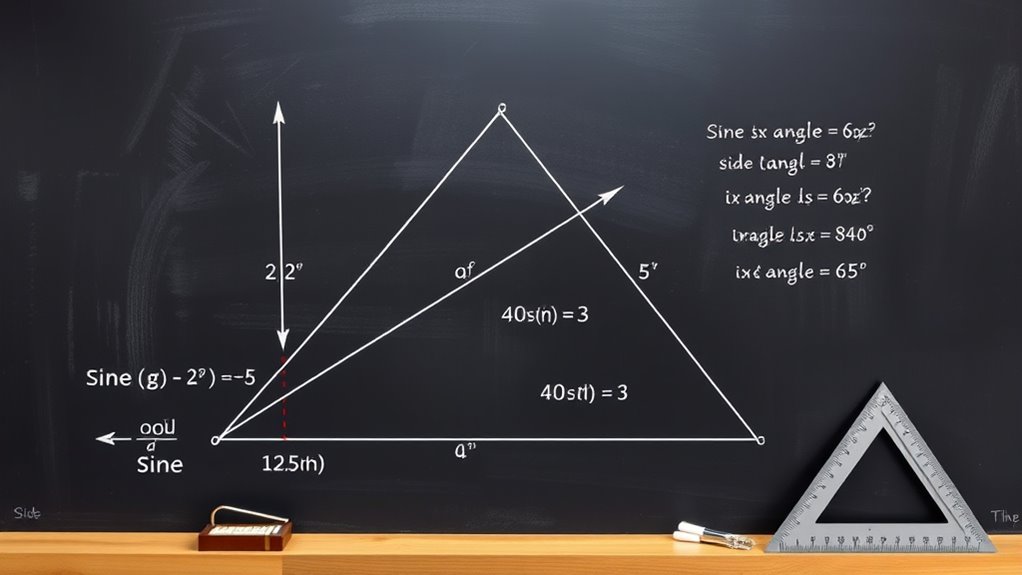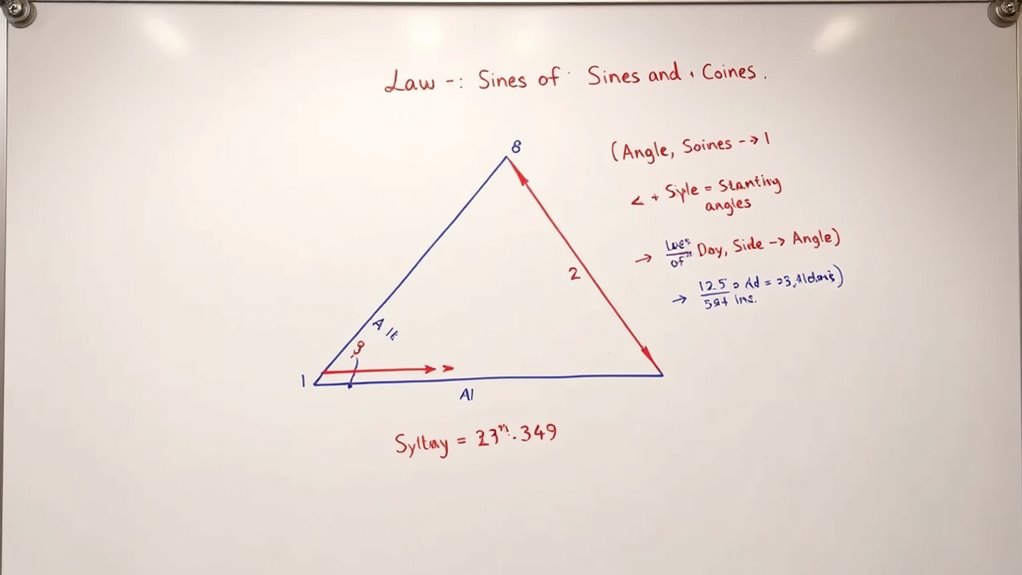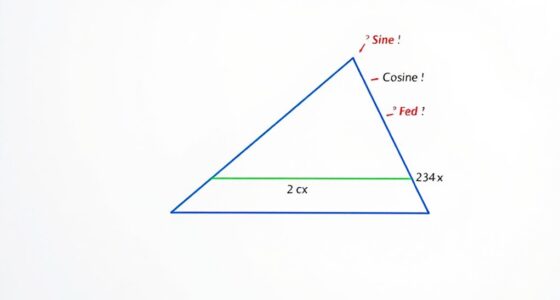Trigonometric identities are essential in geometry as they help simplify angles, find side lengths, and solve triangles. You’ll use fundamental identities, like the Pythagorean ones, to relate sine and cosine, and apply angle sum and difference formulas for complex angles. The Law of Sines and Cosines assist with non-right triangles, making problem-solving more efficient. Keep exploring, and you’ll discover even more ways these identities help solve real-world geometric challenges.
Key Takeaways
- Fundamental identities like sin²θ + cos²θ = 1 enable simplification of geometric expressions and calculations.
- Reciprocal identities convert between functions, aiding in solving complex trigonometric problems in geometry.
- Angle sum and difference formulas help find unknown angles and side lengths in triangles and polygons.
- Law of Sines and Law of Cosines solve for missing sides and angles in non-right triangles.
- Trigonometric identities assist in analyzing geometric figures, calculating slopes, and designing structures in real-world applications.
Fundamental Trigonometric Identities and Their Derivations

Fundamental trigonometric identities are essential tools that provide the foundation for understanding and simplifying various expressions involving angles. By examining the unit circle, you see how sine, cosine, and tangent relate to points on the circle’s circumference. Reciprocal identities link these functions directly: sine is the reciprocal of cosecant, cosine of secant, and tangent of cotangent. These identities help you convert between functions and simplify complex expressions. For example, knowing that csc θ = 1/sin θ allows you to rewrite equations more straightforwardly. The unit circle visually demonstrates these relationships, grounding your understanding of how different trigonometric functions interconnect. Mastering these identities makes solving trigonometric problems more intuitive and lays the groundwork for more advanced concepts. Additionally, understanding the unit circle enables you to see how these identities are derived geometrically and how they apply across various problem-solving scenarios.
Applying Pythagorean Identities in Geometric Problems

Applying Pythagorean identities in geometric problems allows you to find missing side lengths and angle measures efficiently. These identities connect sine and cosine functions, enabling you to leverage sine wave properties to simplify calculations. For example, understanding that (sin^2 theta + cos^2 theta = 1) helps solve for unknown sides in right triangles. Additionally, when analyzing the cosine graph transformations, you can relate shifts and reflections to geometric figures, simplifying complex problems. Recognizing how these transformations influence the sine wave properties allows you to interpret and manipulate trigonometric functions more effectively. This approach streamlines solving problems involving angles and lengths, making it easier to apply fundamental identities in diverse geometric contexts. Furthermore, visualization techniques can aid in understanding how these identities interact within geometric figures, enhancing problem-solving skills.
Using Angle Sum and Difference Formulas to Find Unknowns

Using angle sum and difference formulas allows you to find unknown angles or trigonometric values more efficiently. These formulas help you break down complex angles into simpler parts, making calculations easier. For example, if you know the sine or cosine of two angles, you can use the angle sum or difference formulas to find the value of the sine or cosine of their sum or difference. This is especially useful in solving triangles or verifying identities. By applying the formulas, you can determine unknown side lengths or angles in geometric figures. Remember that the angle sum formulas relate to the sum of two angles, while the difference formulas handle their subtraction. Mastering these formulas streamlines your approach to solving many trigonometric problems in geometry. Additionally, understanding how these identities connect to Glycolic Acid Benefits for Skin can enhance your comprehension of their applications in real-world scenarios.
The Law of Sines and Law of Cosines in Non-Right Triangles

When working with non-right triangles, the Law of Sines and Law of Cosines provide essential tools for finding unknown sides and angles. These laws are particularly useful when you know certain angles and sides, helping you determine the entire triangle’s dimensions. The Law of Sines relates ratios of sides to angles, making it easier to find missing measurements. The Law of Cosines extends this by handling cases where you know two sides and the included angle or all three sides. Understanding these laws helps you calculate the triangle’s area accurately, especially when using coordinate geometry techniques. By applying these identities correctly, you can analyze complex triangles and solve for unknowns efficiently, making them invaluable in advanced geometric problem-solving. Additionally, Ford Tuning techniques often involve precise calculations that can benefit from an understanding of these identities to optimize performance parameters.
Real-World Applications of Trigonometric Identities in Geometry

Trigonometric identities play an essential role in various real-world applications where precise measurements and calculations are vital. In architectural design, these identities help you determine angles and lengths accurately, ensuring structures are both safe and aesthetically pleasing. They assist in calculating slopes, roof angles, and load distributions. In navigation systems, trigonometry allows you to pinpoint locations, plot courses, and measure distances between points on the Earth’s surface. Whether you’re designing a building or charting unfamiliar terrain, understanding these identities enables you to solve complex problems efficiently. Additionally, mastering these formulas can enhance your spatial reasoning skills, which are crucial in many technical fields. By applying trigonometric formulas, you improve accuracy and save time, making them indispensable tools in fields that demand precision and reliability.
Frequently Asked Questions
How Do Trigonometric Identities Simplify Complex Geometric Proofs?
When you face complex geometric proofs, you can simplify them by using trigonometric identities. These identities help you perform angle transformations quickly, making it easier to see relationships between sides and angles. You also use identity derivations to rewrite complicated expressions into simpler forms, saving you time and effort. By applying these strategies, you make your proofs more straightforward and easier to understand, boosting your overall problem-solving efficiency.
Can Trigonometric Identities Be Used to Solve Three-Dimensional Geometric Problems?
Imagine opening a new dimension in your problem-solving toolkit. Yes, trigonometric identities can help you tackle 3D problems, enhancing your spatial reasoning. They provide formulas to find angles and lengths between planes and lines, making complex 3D problem solving more manageable. By applying these identities, you can analyze shapes and solve real-world spatial challenges more efficiently, elevating your understanding of three-dimensional geometry beyond simple shapes.
What Are Common Mistakes When Applying These Identities in Geometry?
When applying these identities, you often make misapplication errors or face simplification pitfalls. You might incorrectly assume identities, leading to wrong results. Sometimes, you over-simplify or skip steps, causing confusion or errors. To avoid these mistakes, double-check each step, verify you’re using the correct identity, and simplify carefully. This approach helps you use trigonometric identities accurately in geometry problems.
How Do Identities Relate to Non-Euclidean Geometries?
You might wonder how identities relate to non-Euclidean geometries like hyperbolic functions and spherical geometry. In these settings, they extend traditional trigonometry, adapting identities to curved spaces. For example, hyperbolic functions describe hyperbolic geometry, while spherical trigonometry uses different identities to handle angles on a sphere. These adaptations help you analyze shapes and angles where Euclidean rules don’t apply, broadening your understanding of geometry’s scope.
Are There Visual Tools to Better Understand These Identities in Geometry?
You can better understand these identities through visual tools like the unit circle and dynamic visualization. The unit circle helps you see how sine and cosine relate to angles, while dynamic visualization allows you to manipulate angles and observe how identities hold true in real-time. These tools make complex relationships clearer, enabling you to grasp the concepts more intuitively and see the geometric connections behind the identities.
Conclusion
Think of trigonometric identities as your trusty toolkit, revealing the secrets of geometry like a master key. With these identities, you can navigate complex shapes and solve problems with confidence. Just as a compass guides a traveler through uncharted territory, these formulas steer you through the world of triangles and angles. Embrace them, and you’ll find that geometry becomes like an exciting adventure, revealing its beauty with every step you take.







